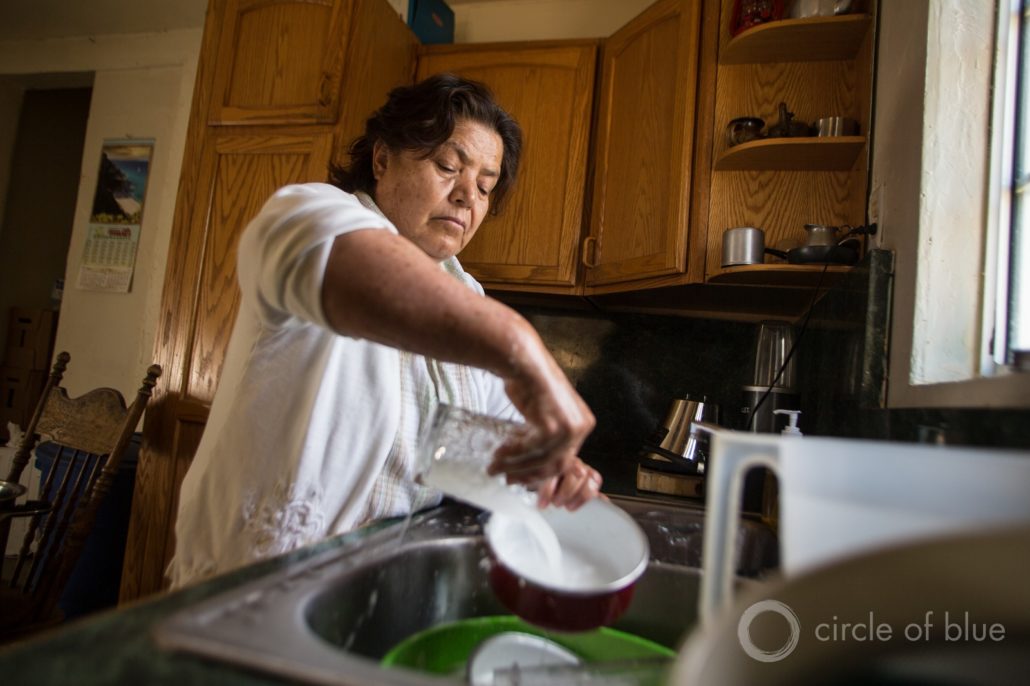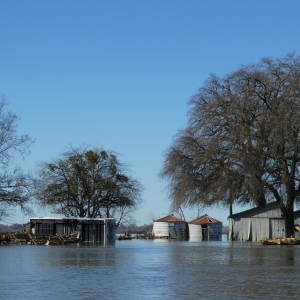The Stream, June 8, 2022: Drought in California Weighs Heavily on Rural Communities

Belan Ruia makes every drop of water count as she washes dishes in April 2015 in her East Porterville, California, home. Like her neighbors, her well went dry during the state’s historic drought. She and her husband, Artemio, got water from a nearby fire station. Photo & copy; J. Carl Ganter / Circle of Blue
YOUR GLOBAL RUNDOWN
- Rural California communities bear the brunt of drought.
- In Mexico, drought forces one city to restrict water use to less than 10 hours a day.
- Brazil is developing new, drought-resistant strains of wheat amid a global shortage.
The U.S. Department of Defense finds high levels of PFAS across a dozen military bases.
“You can only hope now that people know and are finding alternative sources of water because those are shockingly high levels of PFAS.”
– Scott Faber, vice president of government affairs for Environmental Working Group.
Recent testing from the U.S. Department of Defense revealed high levels of PFAS contamination near at least 12 military bases. PFAS, a class of chemical compounds that notoriously do not break down naturall in the environment, are common on military bases where fire extinguisher is used during training exercises and emergencies. The chemicals often contaminate drinking water sources of nearby residents, and have been linked to cancer, kidney disease, birth defects, decreased immunity, liver problems, and more.
— Jane Johnston, Stream Editor
Podcast: What’s Up With Water
Tune into What’s Up With Water for your need to know news of the world’s water on Apple Podcasts, Spotify, iHeartRadio, and SoundCloud.
Featured coverage from this week’s episode of What’s Up With Water looks at:
- In France, May was unusually warm, and that could limit operations at some of its nuclear power facilities. Most inland facilities cool their power-generating equipment with river water.
- In Somalia, the risk of famine is growing as a severe drought shows no sign of abating. The United Nations’ top humanitarian official for the Horn of Africa toured a displaced persons camp last week to observe the struggles.
- As the global price for wheat skyrockets, farmers in Iraq tell the Associated Press that they don’t have enough water to grow their crops. Last year, the country’s Agriculture Ministry decided to cut irrigation water allocations by half.
More WaterNews from Circle of Blue
What Does Water Want?: A Conversation with Author Erica Gies – The problems and opportunities that spring from a mismatch between the natural world and the built environment are the topic of Water Always Wins, a new book from journalist Erica Gies.
What Happens If Glen Canyon Dam’s Power Shuts Off? – Lake Powell is drying behind one of the Southwest’s largest hydropower plants.
Rural Californians Can’t Keep the Tap Running as Cities Struggle to Cut Use
As major California cities struggle to cut water use, some small towns across the state haven’t had reliable water in years. Many rural residents rely on groundwater for drinking and bating. Much of that water has dried up in recent years, or in some cases, has been contaminated with arsenic, nitrates, or other toxic chemicals. One man, 72-year-old Gary Briggs from West Goshen, told CNN that the Central Valley is “dying” because others refuse to grasp the gravity of the drought.
- In Context: Some rural California communities have waited nearly a decade for state regulators to repair their tainted drinking-water systems, reported California Health Report last year. Relentless hot and dry spells have dried up the groundwater wells that many others, like Maralee and Noal Childs in Glenn County, rely on.
This Week’s Top Water Stories, Told In Numbers
6 HOURS
The major Mexican city of Monterrey, whose metropolitan area is home to 5.3 million people, will limit daily water access for residents to just six hours. The decision comes amid historic drought in the border state of Nuevo Leon. The state’s previous policy limited water use to one day per week, based on location.
On the Radar
As Russia’s invasion into Ukraine continues, global supplies of wheat have dwindled. In an effort to become more self-sufficient, Brazil farmers are testing a variety of drought-resistant strains of the crop. While other commodity crops like soy and corn are almost entirely cultivated with genetically modified seeds, consumers have historically opposed the use of the technology for wheat because it is directly consumed by people, rather than livestock.
More Water News
A major conveyor belt of ocean currents is slowing down due to climate change. If it collapses, La Niña could become normal in Australia.
A recent report reveals the toll of climate change in India.
Jane is a Communications Associate for Circle of Blue. She writes The Stream and has covered domestic and international water issues for Circle of Blue. She is a recent graduate of Grand Valley State University, where she studied Multimedia Journalism and Women, Gender and Sexuality Studies. During her time at Grand Valley, she was the host of the Community Service Learning Center podcast Be the Change. Currently based in Grand Rapids, Michigan, Jane enjoys listening to music, reading and spending time outdoors.






Leave a Reply
Want to join the discussion?Feel free to contribute!